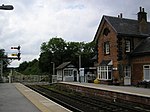RAF Marston Moor

RAF Marston Moor was a Royal Air Force airfield at Tockwith, North Yorkshire, during the Second World War. It was originally called RAF Tockwith, but confusion with RAF Topcliffe led to the name change.RAF Marston Moor was opened on 11 November 1941, the airfield and RAF Church Fenton were the closest airfields to West Yorkshire and would act as a defence should Leeds be attacked. As it happens Leeds was seldom bombed. In 1943, Group Captain Leonard Cheshire was made the station commander. He requested to be transferred to the command of 617 Squadron in November 1943, a vacancy created by the loss of George Holden in July of that year. The move required him to voluntarily step down in rank from group captain to wing commander, which he did. Marston Moor was also in control of RAF Rufforth and RAF Riccall.During the war, American actor Clark Gable was stationed at the airfield before being relocated to RAF Polebrook.
Excerpt from the Wikipedia article RAF Marston Moor (License: CC BY-SA 3.0, Authors, Images).RAF Marston Moor
Rudgate,
Geographical coordinates (GPS) Address Nearby Places Show on map
Geographical coordinates (GPS)
| Latitude | Longitude |
|---|---|
| N 53.961666666667 ° | E -1.3044444444444 ° |
Address
Tockwith Motor Sports
Rudgate
YO26 7PD , Tockwith
England, United Kingdom
Open on Google Maps









